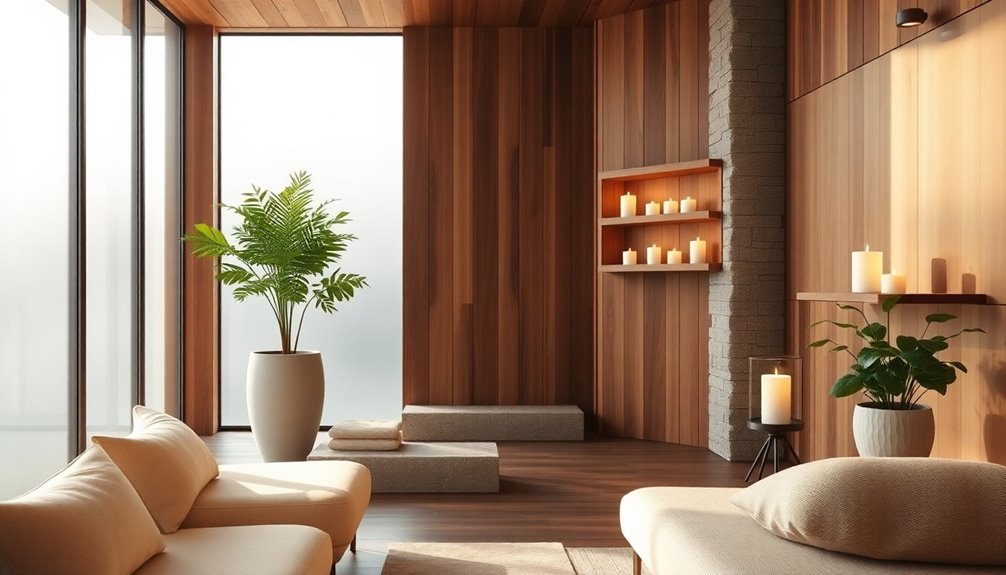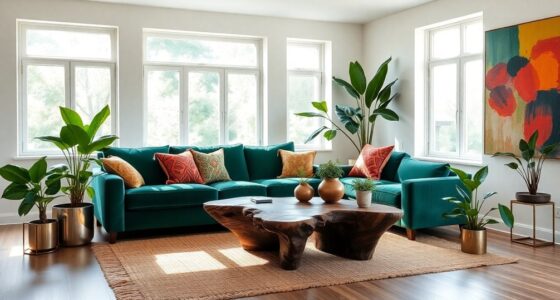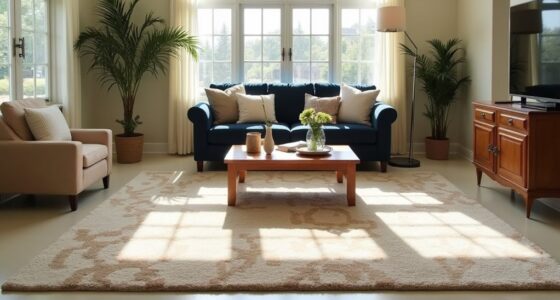When designing your wellness space, consider incorporating natural elements like wood and stone to create warmth and tranquility. Use soothing lighting, such as dimmable fixtures, to set the perfect ambiance. Comfortable seating arrangements with ergonomic furniture and plush textiles enhance relaxation. Integrate water features for a calming effect and create dedicated relaxation zones for mindfulness. Plan your layout strategically to improve flow and accessibility while maintaining sustainability with eco-friendly materials. With the right design concepts, your spa can become a true sanctuary. Stay tuned to explore more inspiring ideas that will transform your space into a haven of wellness.
Key Takeaways
- Incorporate natural elements like wood, stone, and indoor plants to create a warm, biophilic environment that promotes relaxation and well-being.
- Utilize soothing lighting options, such as dimmable fixtures and soft, indirect lights, to foster a calming ambiance throughout the spa.
- Design comfortable and flexible seating arrangements with ergonomic furniture and plush textiles to enhance guest comfort and encourage relaxation.
- Integrate water features and dedicated relaxation zones to deepen connections with nature and provide tranquil spaces for mindfulness practices.
- Plan a strategic layout that distinguishes between wet and dry zones, ensuring smooth traffic flow and accessibility for all clients.
Natural Elements in Spa Design

When designing a spa, incorporating natural elements can significantly enhance the ambiance and overall experience. You can start by using wood accents for flooring and furniture, bringing warmth and a touch of nature indoors. Adding stone elements, like countertops and wall accents, creates a sustainable vibe. Don't forget to integrate plants; they not only add greenery but also purify the air and enhance relaxation. Opt for natural textures, such as wood grain and organic fabrics, to enrich the tactile experience. Choose an earthy color palette with greens, browns, and blues to promote a calming atmosphere. Additionally, utilizing sustainable materials supports an eco-friendly environment that resonates with today's wellness-focused approach in the beauty industry.
Soothing Lighting Techniques
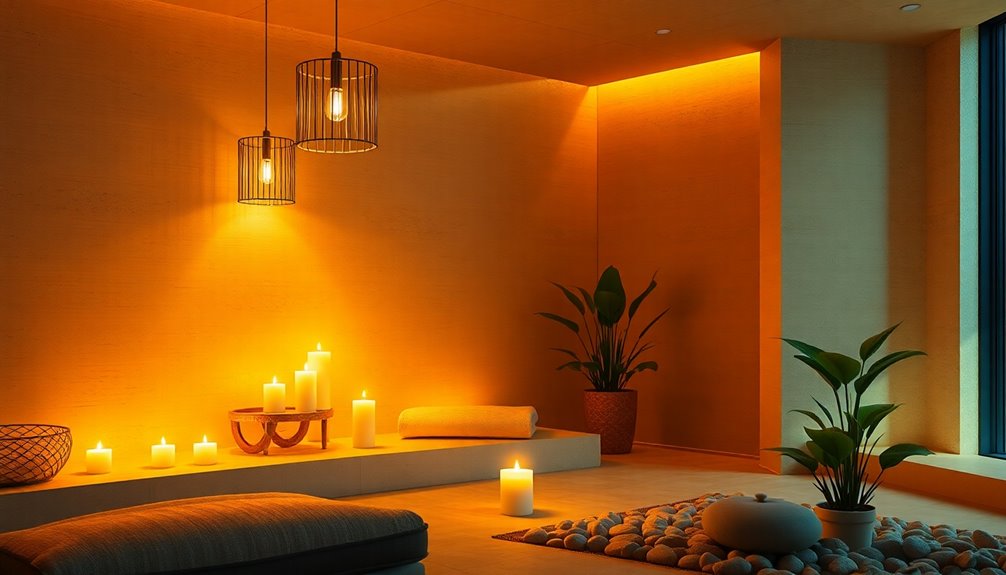
Natural elements create a serene atmosphere in spa design, but the right lighting can elevate that experience even further.
Start with soft, indirect lighting using warm light sources between 2200 K and 3000 K to foster a cozy ambiance. Choose low-intensity lights for relaxation areas to keep guests calm. Proper brightness levels are essential for safety and practical use in these spaces.
In massage rooms, install dimmable fixtures, allowing you to adjust light intensity as needed. Reflective lighting in showers and focal points around the pool can enhance the environment without overwhelming guests.
Avoid harsh fluorescents; instead, opt for recessed LED or string lights with soft hues for a meditative feel. Customizable lighting can adapt to the time of day, ensuring your space remains inviting and tranquil.
Comfortable Seating Arrangements
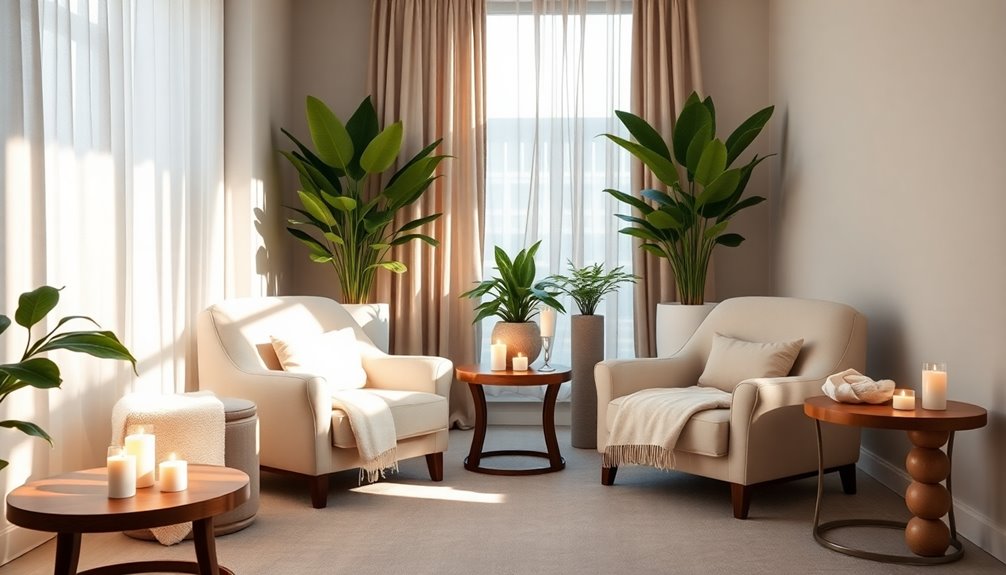
Creating a relaxing spa environment hinges on comfortable seating arrangements that invite guests to unwind. Invest in ergonomic furniture like reclining chairs and adjustable massage tables to ensure optimal comfort during treatments. Incorporating natural elements such as plants and wood can further enhance the soothing atmosphere of your space.
Plush textiles, such as soft upholstery and thick pillows, add a cozy touch to your space. Customizable seating options allow you to tailor experiences to individual preferences, while intuitive layouts encourage easy navigation.
Designate quiet zones for relaxation and create social areas for interaction, ensuring a balance of privacy and connection. Don't forget additional amenities like heated seats and footrests to enhance comfort.
Holistic Wellness Spaces
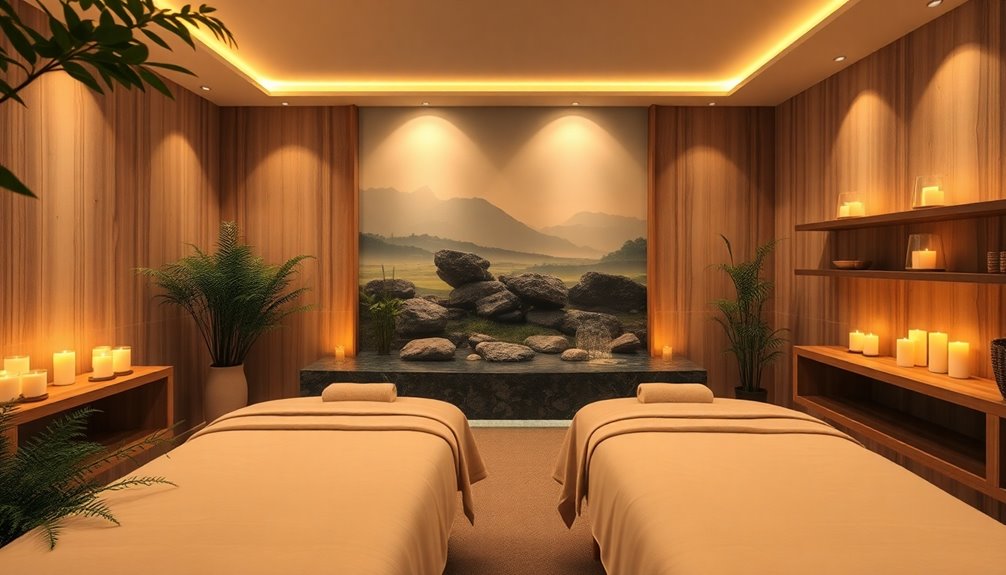
Comfortable seating arrangements lay the groundwork for a tranquil spa experience, but to truly elevate the ambiance, incorporating holistic wellness spaces is key.
Start by using natural materials like wood and stone to connect with nature. Fill your space with indoor plants that enhance air quality and vitality. Let in ample natural light to create a calming atmosphere, and consider adding soothing water features for their therapeutic qualities. Additionally, ensure that your design incorporates natural light benefits to improve mood and overall well-being. Understanding the importance of consumer awareness in selecting the right materials can further enhance the sustainable aspect of your design.
Engage the senses with soft fabrics and thoughtful lighting schemes, while incorporating comforting scents and sounds. Design dedicated meditation areas to promote mindfulness, and ensure clean air to boost well-being.
Ultimately, embrace a holistic philosophy that nurtures the mind, body, and spirit for a truly rejuvenating experience.
Strategic Layout Planning
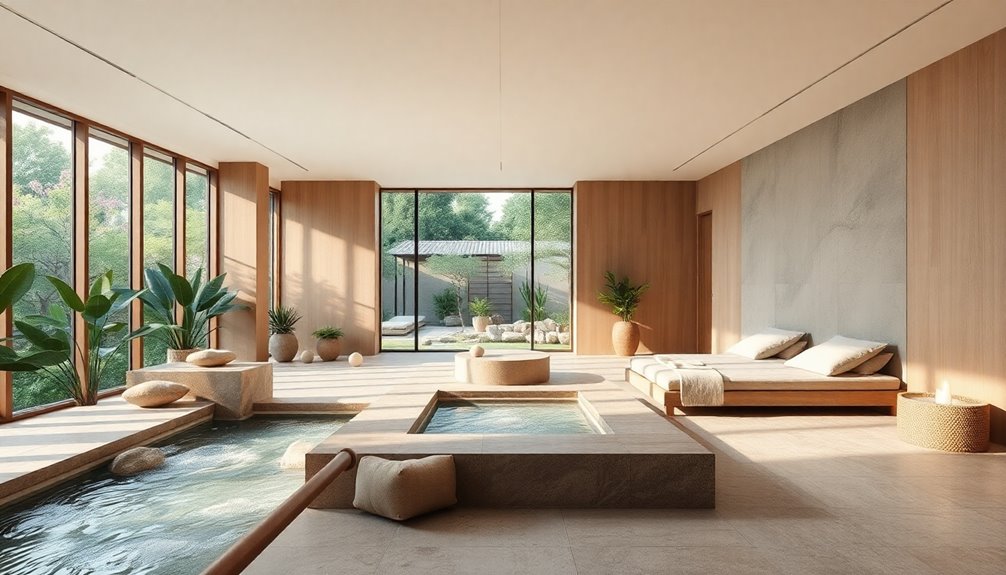
While designing a spa, strategic layout planning is essential for crafting an inviting and functional space. You want to ensure smooth traffic flow by clearly distinguishing wet and dry zones, relaxation areas, and treatment rooms. This helps guests navigate seamlessly from reception to treatment areas.
Consider sightlines and spatial relationships, providing peaceful views in relaxation zones and privacy in treatment rooms. Accessibility is crucial, so create an inclusive layout for all clients. Incorporating soundproofing techniques can further enhance the tranquil atmosphere, minimizing distractions during treatments.
Design functional zones like a conveniently located reception and consultation room, multifunctional treatment spaces, and accessible retail areas. Prioritize client comfort with thoughtful ambiance and efficient operational setups, allowing for a serene experience that enhances overall satisfaction.
Texture and Sensory Experiences

Textures and sensory experiences play a vital role in enhancing the overall atmosphere of a spa. Incorporate soft fabrics like plush robes and towels to engage your guests' sense of touch. Consider textured walls made of wood or stone, and smooth surfaces like marble countertops for a soothing feel. Warm textures, such as heated stones and cozy blankets, can elevate relaxation. For an immersive experience, use aromatherapy with natural scents and calming music to stimulate the senses. Offering infused water for a delightful taste engagement can be complemented by the use of essential oils known for their relaxing properties. Create a multisensory environment by integrating nature-inspired elements, soothing colors, and soft lighting, ensuring your guests can fully immerse themselves in the tranquil ambiance you've designed. Notably, multisensory treatments can significantly enhance emotional well-being by engaging multiple senses in a cohesive experience.
Art and Décor Choices
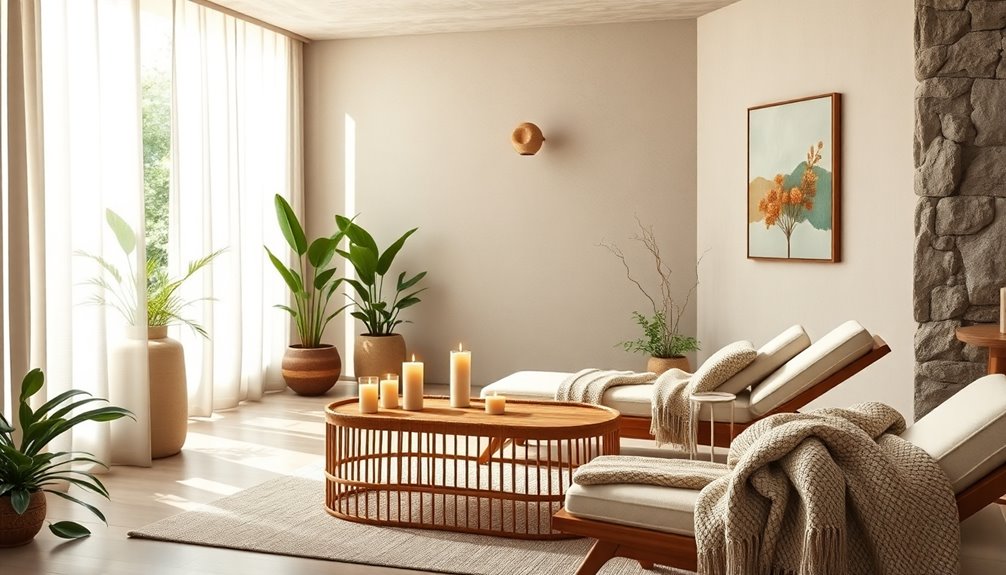
Creating a serene atmosphere in your spa extends beyond textures and sensory experiences; it also involves thoughtful art and décor choices.
Consider incorporating mosaic art for its water resistance and ease of cleaning, allowing you to customize designs that align with your spa's color palette.
Ceramic art offers versatility with intricate, nature-inspired designs, enhancing tranquility.
For a natural touch, use wood art—dyed or raw—to add warmth and texture, ensuring it's protected with specialist coatings. Durable and resistant to moisture when treated, wood art ensures longevity in your spa interiors.
Glass art can transform your space through translucent partitions, creating an immersive atmosphere.
Each of these elements not only beautifies but also fosters a calming environment, inviting guests to unwind and rejuvenate in your wellness sanctuary.
Incorporating Water Features
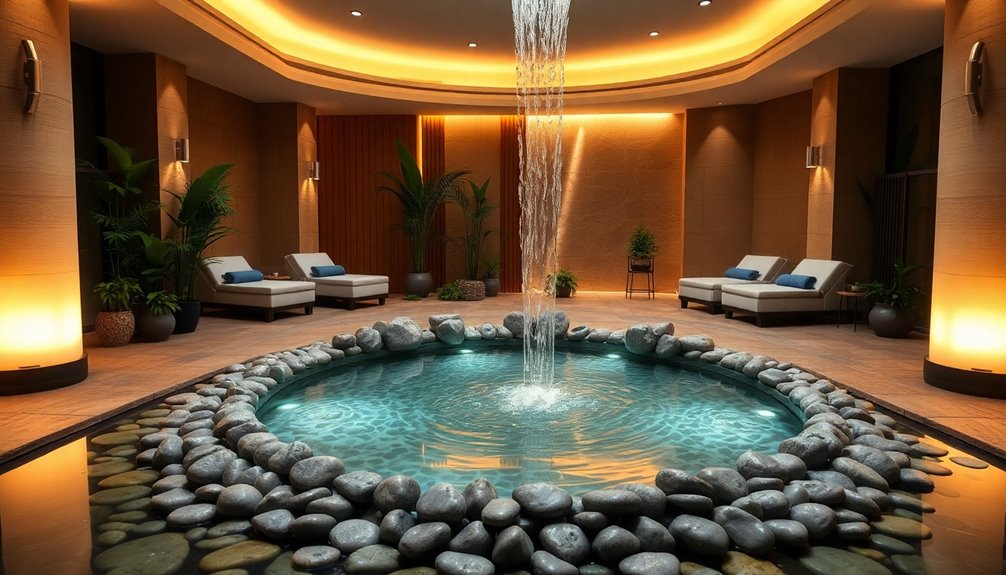
Incorporating water features into your spa not only elevates the aesthetic appeal but also enhances the overall sensory experience for your guests.
Consider installing sleek fountains with LED lighting for stunning nighttime displays, or elegant water bowls that channel water through various finishes like brass or stainless steel.
Deck jets and laminars can create captivating visuals, while reverse infinity pools offer an artistic edge. Additionally, these features are customizable to individual aesthetic preferences, allowing for a unique touch that reflects your spa's identity.
Thoughtful placement is crucial; position these features near relaxation areas or treatment rooms to maximize tranquility.
Use eco-friendly materials like stainless steel and natural stones to blend seamlessly with your design.
The soothing sounds of flowing water will foster a calming atmosphere, making your spa a memorable retreat that keeps guests coming back.
Biophilic Design Principles

By embracing biophilic design principles, you can transform your spa into a serene sanctuary that reconnects guests with nature.
Start by incorporating large windows and skylights to bring in natural light and stunning views of the outdoors. Infinity pools overlooking serene water features enhance this connection, especially when they provide immersive views of the surrounding woodland landscape.
Extend your spa outdoors with yoga decks or herb gardens, creating seamless transitions between indoor and outdoor spaces.
Integrate sounds of nature, like flowing water, and use organic materials to evoke nature's aromas and textures.
Allow for dynamic light and subtle airflow variations to mimic the outdoors.
Finally, utilize local materials and designs that reflect the surrounding environment, ensuring your spa harmonizes beautifully with nature.
Creating Relaxation Zones
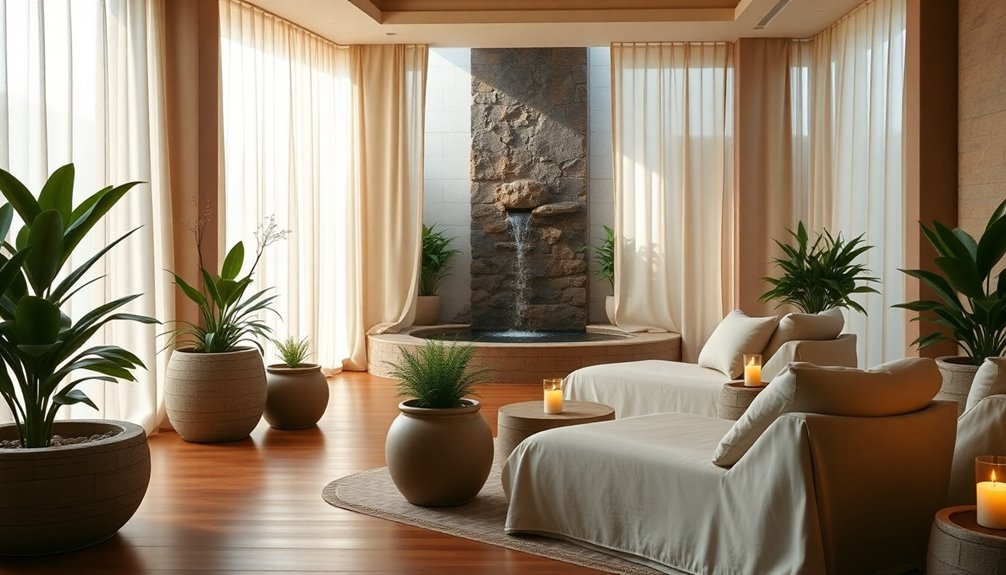
To enhance the serene atmosphere established through biophilic design, relaxation zones play a pivotal role in encouraging guests to unwind and rejuvenate.
Start by selecting calming colors like soft neutrals and pastels, paired with natural light from large windows or skylights. Incorporate natural elements, such as wood, stone, and indoor plants, to deepen the connection with nature. The use of open floor plans can further maximize airflow and create a more inviting space.
Ensure your furnishings are plush and ergonomic, using soft fabrics for added comfort. Enhance sensory experiences with aromatherapy through essential oils and calming music or nature sounds. Incorporating nature-inspired elements can significantly boost the overall tranquility of your wellness space.
Finally, create flexible lighting options to suit various moods. Together, these elements create a tranquil oasis, allowing guests to fully immerse themselves in relaxation and wellness.
Frequently Asked Questions
What Budget Should I Allocate for Spa Interior Design?
When you're setting a budget for spa interior design, consider several key factors.
First, think about your location and space size, as these influence costs significantly. Quality materials and furnishings will also impact your budget, so choose wisely.
Don't forget renovation expenses, which can add up quickly. Lastly, factor in additional costs like licenses, marketing, and staff training.
How Do I Choose a Theme for My Spa?
Choosing a theme for your spa is like planting a garden. You need to know your soil—understand your target audience.
Identify the flowers that set your spa apart, and let the sunlight of your location shine through. Cultivate a color palette and design elements that evoke tranquility.
Ensure every path leads to relaxation, keeping the essence of your brand alive. With careful planning, you'll create an oasis where guests can truly unwind.
What Are the Latest Spa Design Trends?
You'll find the latest spa design trends emphasize natural elements, like wood and stone, to create a calming atmosphere.
Incorporating ambient lighting and aromatherapy enhances relaxation, while soft neutrals and pastels provide a soothing backdrop.
Look for biophilic designs that connect guests with nature, and consider eco-friendly materials to promote sustainability.
Additionally, integrating stone-inspired features can add a luxurious touch, making your wellness space both inviting and rejuvenating for all who enter.
How Can I Maintain My Spa's Ambiance?
To maintain your spa's ambiance, focus on cleanliness and sensory experiences. Clean high-traffic areas daily and deep clean treatment spaces weekly.
Use calming colors and natural materials in your design, and incorporate soothing scents and sounds to enhance relaxation.
Regularly update decor and ensure proper air quality. Prioritize the maintenance of equipment and facilities to keep everything inviting.
What Permits Are Needed for Spa Renovations?
Navigating the world of spa renovations can feel like walking through a maze.
To start, you'll need building permits for any permanent installations and electrical permits for safety compliance. If heating equipment's involved, a mechanical permit is also necessary.
Don't forget to check local regulations, as some subdivisions might've additional restrictions.
Submit your applications online through the county's eServices, and ensure you include the manufacturer's specifications for a smoother process.
Conclusion
Incorporating these spa interior design concepts can transform your space into a serene oasis, like a peaceful retreat tucked away in nature. By blending natural elements, soothing lighting, and comfortable seating, you create an environment that promotes wellness and relaxation. Remember to consider every detail, from your layout to the art you choose, ensuring each element contributes to your sanctuary. Embrace these ideas, and watch your wellness space flourish into a haven of tranquility.
